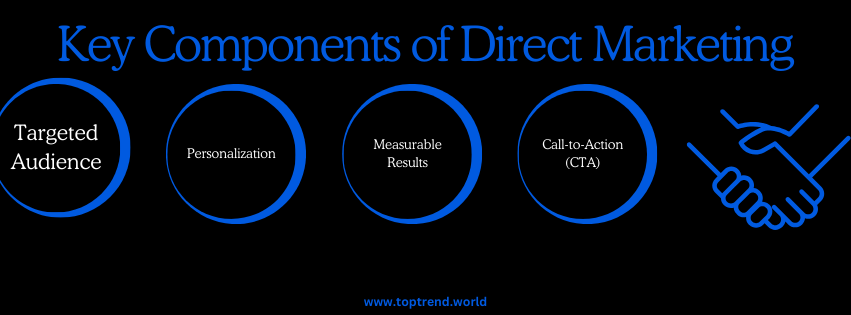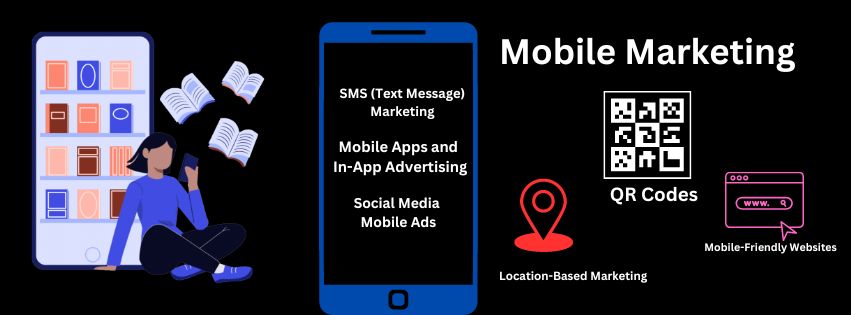Direct marketing is a marketing strategy that involves reaching out to potential customers directly with targeted messages or offers, without intermediaries like retailers or mass media outlets. The goal is to elicit an immediate response or encourage a direct action, such as making a purchase, signing up for a service, or visiting a website. With its highly personalized and measurable approach, direct marketing allows businesses to connect with consumers in a more focused and efficient way.
In this blog, we’ll dive into what direct marketing is, its key components, advantages, popular channels, and how to create an effective direct marketing campaign.

What is Direct Marketing?
Direct marketing is a form of advertising where companies reach out directly to consumers through various channels such as email, SMS, social media or telemarketing. The primary objective is to create a personalized experience that drives an immediate action. Unlike indirect marketing, where awareness and reputation are built over time, direct marketing aims for instant engagement and measurable results.
- Personalized messaging targeted at specific segments of the audience.
- Clear calls-to-action (CTAs) that encourage the recipient to take immediate action.
- Tracking mechanisms that allow businesses to measure the effectiveness of the campaign in real time.
Key Components of Direct Marketing
Targeted Audience
- One of the defining characteristics of direct marketing is its focus on a specific audience. Marketers use customer data to segment their audience and create personalized messages for each group. Whether it’s demographics, purchasing behavior, or interests, having detailed information about your audience helps tailor the message for maximum impact.
Personalization
- Direct marketing messages are highly personalized. Whether it’s addressing the recipient by name, offering tailored product recommendations, or using past purchase data to inform the offer, personalization helps grab attention and boosts engagement.
Measurable Results
- Direct marketing campaigns are designed with clear metrics in mind. Whether it’s tracking click-through rates, conversion rates, or sales, businesses can quickly determine the success of their campaigns. This allows for more effective budget allocation and optimization.
Call-to-Action (CTA)
- A strong CTA is essential in direct marketing. It clearly tells the audience what action they should take next, whether it’s clicking a link, calling a number, or visiting a store. The CTA should be easy to follow and offer an incentive to take immediate action (e.g., discounts, limited-time offers).
Advantages of Direct Marketing
Highly Targeted
- Direct marketing allows businesses to zero in on specific segments of their customer base. Instead of casting a wide net with mass advertising, direct marketing delivers tailored messages that are more relevant to the recipient, which leads to higher conversion rates.
Cost-Effective
- By focusing on a defined audience, direct marketing eliminates the costs associated with mass media campaigns. Whether through email, SMS, or social ads, businesses can reach the right people without overspending.
Immediate Response
- With a clear CTA, direct marketing encourages recipients to act quickly. Whether it’s making a purchase, signing up for a newsletter, or downloading an app, the approach is designed to elicit an immediate response.
Easily Measurable
- One of the biggest benefits of direct marketing is its measurability. Marketers can track everything from open rates and click-through rates to conversions and sales. This provides valuable insights into what’s working and what isn’t, allowing for real-time adjustments.
Personal Connection
- By personalizing messages, direct marketing can foster a stronger connection between the brand and the consumer. Personalized offers, content, and recommendations make the customer feel valued, which can lead to increased loyalty and repeat business.
Popular Channels for Direct Marketing
Email Marketing
- Email is one of the most common and effective forms of direct marketing. With personalized subject lines, tailored content, and clickable CTAs, businesses can engage their audience directly in their inbox. Email marketing also offers automation tools, enabling marketers to send timely, personalized messages based on user behavior.
- Example: A clothing retailer might send a personalized email to a customer recommending items based on their previous purchases, with an incentive such as a discount on their next purchase.
SMS Marketing
- SMS (text message) marketing allows businesses to reach customers instantly with short, compelling messages. With high open rates, SMS marketing is effective for time-sensitive offers like flash sales, appointment reminders, or event promotions.
- Example: A restaurant could send out an SMS offering 20% off for customers who come in for lunch that day, driving immediate foot traffic.
Direct Mail
- Traditional direct mail campaigns involve sending physical mail, such as postcards, catalogs, or flyers, to a targeted audience. While digital channels are growing in popularity, direct mail still works well for certain industries and customer segments. It’s tangible, often personalized, and can stand out in a world saturated with digital messages.
- Example: A luxury brand might send a high-end catalog featuring its latest collection to loyal customers, complete with a personalized note.
Telemarketing
- Telemarketing involves reaching out to customers over the phone to promote a product or service. While it can be intrusive, telemarketing is effective when targeted at specific groups, such as existing customers who might be interested in upgrades or additional services.
- Example: A telecommunications company might call existing customers to offer a new bundle or service upgrade.
Social Media Direct Messaging
- Brands can use direct messaging on social media platforms like Facebook, Instagram, or LinkedIn to connect directly with customers or prospects. This is especially effective for B2B companies or for resolving customer service issues quickly and personally.
- Example: A SaaS company might use LinkedIn to message business prospects about a free demo or trial of their software.
Targeted Online Ads
- Display ads, social media ads, and search engine ads allow for direct marketing with highly specific targeting. Using data like browsing history, past purchases, and demographics, companies can display ads that are relevant to individual users, driving immediate conversions.
- Example: A fitness app might display targeted ads to people who have previously visited their website, offering them a discount on their first subscription.
How to Create an Effective Direct Marketing Campaign
Define Your Audience
- Start by identifying your target audience. Use customer data to create segments based on demographics, behaviors, purchase history, or interests. The more you know about your audience, the more personalized and relevant your messages can be.
Set Clear Objectives
- What is the goal of your direct marketing campaign? Whether you want to increase sales, generate leads, or boost engagement, having a clear objective will help guide your strategy and measure success.
Craft Personalized and Compelling Messages
- Personalization is key in direct marketing. Use the recipient’s name, reference past interactions, and make the message as relevant as possible. Tailor your offer to their needs or interests, and make sure the content is compelling enough to prompt immediate action.
- Include a Strong Call-to-Action (CTA)
- Every direct marketing message should have a clear and actionable CTA. Whether it’s “Buy Now,” “Sign Up Today,” or “Claim Your Discount,” the CTA should guide the recipient toward the desired action.
- Choose the Right Channels
- Depending on your audience and objectives, select the channels that will best reach your customers. Some audiences may respond better to email, while others prefer SMS or social media. Consider using a mix of channels to maximize reach and impact.
- Test and Optimize
- Before launching a full campaign, run A/B tests on your messages, subject lines, offers, and CTAs. Measure the results to determine what resonates best with your audience, and use that data to optimize future campaigns.
- Track and Measure Performance
- Use analytics tools to monitor the success of your campaign in real-time. Track key metrics like open rates, click-through rates, conversion rates, and ROI. This data will help you assess the effectiveness of your campaign and make necessary adjustments.
Examples of Successful Campaigns
- Amazon’s Personalized Product Recommendations
- Amazon is a master of direct marketing, using customer purchase history and browsing behavior to send highly personalized email recommendations. These emails often feature products that the customer is likely to be interested in, leading to high conversion rates.
- Warby Parker’s Direct Mail Campaign
- Warby Parker, the eyewear retailer, uses direct mail to send customers beautifully designed catalogs featuring their latest collections. The tangible nature of the mail, combined with the option to try glasses at home, has been a successful strategy for the brand.
- Spotify’s Personalized Year-End Recap
- Spotify’s “Wrapped” campaign is a great example of personalized direct marketing. Each year, the music streaming service sends users a recap of their listening habits, with fun statistics and insights. This campaign not only drives engagement but also encourages users to share their results on social media, amplifying the campaign’s reach.
Conclusion
Direct marketing is a powerful strategy for reaching customers with personalized, relevant messages that drive immediate action. By leveraging data and targeting specific segments, businesses can create more meaningful connections with their audience while optimizing their marketing budget. Whether through email, SMS, or social media, direct marketing offers a measurable and effective way to increase sales, generate leads, and build long-lasting relationships with customers.
To succeed with direct marketing, focus on crafting compelling, personalized messages, delivering clear CTAs, and consistently optimizing your campaigns based on data and customer feedback. With the right approach, direct marketing can significantly boost your business’s





lsCIfcZOhYeTdp